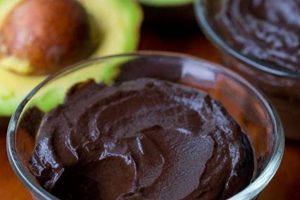A dessert preparation involves blending the richness of chocolate with the creamy texture of avocado, formulated to exclude all animal products. This results in a sweet treat suitable for individuals adhering to plant-based diets or those with specific dietary restrictions. The avocado serves as a substitute for traditional ingredients like eggs and dairy, imparting a smooth consistency while contributing beneficial fats.
The significance of this dessert lies in its ability to provide a satisfying and indulgent experience without compromising ethical or health-related principles. It offers a viable alternative for those seeking to reduce their consumption of animal products or manage dietary sensitivities. Its emergence reflects a broader trend towards innovative food solutions that prioritize both taste and nutritional value, aligning with growing awareness of sustainable and health-conscious eating habits.
The subsequent sections will delve into the specific ingredients used in this formulation, exploring their individual contributions to the final product. The preparation methods will be outlined in detail, followed by an analysis of its nutritional profile and a discussion of potential variations and serving suggestions.
Preparation Guidance
Maximizing the outcome of this plant-based dessert requires careful attention to ingredient selection and procedural execution. The following guidelines are designed to enhance the final product’s texture, flavor, and overall appeal.
Tip 1: Avocado Ripeness: Employ avocados at peak ripeness. Overripe avocados can introduce undesirable flavors and textures, while underripe avocados lack the necessary creaminess. The avocado should yield gently to pressure without being mushy.
Tip 2: Chocolate Selection: Opt for high-quality dark chocolate with a cocoa content of at least 70%. The intensity of the chocolate directly influences the depth of flavor in the mousse. Consider using chocolate with a higher percentage for a more pronounced taste.
Tip 3: Sweetener Management: Natural sweeteners such as maple syrup or agave nectar are often used. Adjust the quantity according to individual preference, but be mindful of the overall moisture content of the dessert. Excessive liquid can compromise the mousse’s structure.
Tip 4: Blending Technique: Achieving a smooth, homogenous texture is critical. Utilize a high-speed blender or food processor to ensure complete integration of ingredients. Scrape down the sides of the container periodically to prevent any unincorporated avocado from remaining.
Tip 5: Chilling Duration: Adequate chilling time is essential for the mousse to set properly. Refrigerate for at least two hours, or preferably longer, before serving. This allows the flavors to meld and the texture to firm.
Tip 6: Flavor Enhancements: Consider incorporating flavor enhancers such as vanilla extract, a pinch of sea salt, or a small amount of espresso powder to accentuate the chocolate’s richness. These additions can subtly elevate the overall taste profile.
Consistent adherence to these recommendations will result in a dessert characterized by a smooth, decadent texture and a rich, balanced flavor profile. The emphasis on ingredient quality and meticulous preparation ensures a superior plant-based culinary experience.
The subsequent discussion will address potential variations and modifications to this recipe, accommodating diverse dietary needs and flavor preferences.
1. Texture
The textural profile of a chocolate mousse prepared with avocado, while remaining free of animal products, constitutes a primary attribute influencing its overall palatability and consumer acceptance. Achieving a desirable consistency necessitates a precise understanding of ingredient interactions and preparation techniques.
- Avocado as Emulsifier and Thickening Agent
The avocado functions as a natural emulsifier and thickening agent, replacing the traditional role of eggs and dairy cream. Its high fat content and smooth consistency contribute to the mousse’s richness and mouthfeel. The selection of optimally ripe avocados is critical, as underripe or overripe specimens will negatively impact the final texture.
- Influence of Chocolate Type on Mouthfeel
The type and quality of chocolate utilized directly affect the mousse’s textural qualities. Dark chocolate with a higher cocoa butter content typically yields a smoother and more decadent sensation on the palate compared to lower-quality alternatives. The particle size of the chocolate also influences the overall smoothness; finely ground chocolate is preferred.
- Impact of Blending Technique on Consistency
Proper blending is essential to achieve a uniform and aerated texture. Over-blending can result in a dense and gummy mousse, while under-blending may leave undesirable lumps of avocado. High-speed blenders or food processors are recommended to ensure thorough incorporation of all ingredients and the creation of a smooth, homogenous mixture.
- Effect of Chilling on Final Texture
The chilling process plays a significant role in solidifying the mousse and enhancing its textural properties. Refrigeration allows the fats in the avocado and chocolate to solidify, resulting in a firmer, more stable structure. The duration of chilling directly influences the final texture, with longer chilling times generally yielding a more solid consistency.
The interplay between avocado properties, chocolate characteristics, blending methodology, and chilling duration collectively determines the ultimate textural experience of this dessert. Precise control over these factors is paramount in creating a product that meets or exceeds the expectations associated with traditional mousse preparations, while adhering to plant-based dietary guidelines.
2. Richness
The perception of “richness” in a chocolate mousse, especially one incorporating avocado and excluding animal products, is a multifaceted sensory experience derived from flavor intensity, textural depth, and ingredient quality. It is a key determinant of consumer satisfaction and contributes significantly to the overall appeal of the dessert.
- Cocoa Content and Quality
The percentage of cocoa solids and the inherent quality of the chocolate used are primary drivers of richness. Higher cocoa percentages impart a more intense chocolate flavor and a greater depth of bitterness, contributing to a richer taste profile. Single-origin chocolates, for example, often possess distinct flavor notes that enhance the overall sensory experience. The selection of premium cocoa directly translates to a more pronounced and satisfying richness.
- Avocado Fat Profile
The avocado contributes a significant portion of the fat content, which is essential for creating a creamy and luxurious mouthfeel. Unlike saturated fats commonly found in traditional mousse recipes, avocado provides monounsaturated fats, perceived as healthier. This lipid profile contributes to a lingering sensation of richness without the heaviness associated with dairy-based alternatives. The quality and ripeness of the avocado are critical to maximizing this effect.
- Sweetness Modulation
The level and type of sweetener used influence the perception of richness. While adequate sweetness is necessary to balance the bitterness of the chocolate, excessive sweetness can mask the nuanced flavors and diminish the overall richness. The selection of natural sweeteners like maple syrup or dates can impart additional flavor complexities that complement the chocolate, contributing to a more integrated and satisfying richness.
- Flavor Enhancements and Complexity
The strategic use of flavor enhancers can amplify the perception of richness. Ingredients like vanilla extract, espresso powder, or a pinch of sea salt can accentuate the chocolate’s inherent flavors and create a more complex and nuanced taste profile. These additions contribute to a layered sensory experience, enhancing the overall feeling of indulgence and richness.
In summary, the richness of a chocolate mousse created with avocado and free of animal products is not solely dependent on any single ingredient but rather on the harmonious interplay of high-quality components, careful flavor balancing, and skillful preparation techniques. By focusing on cocoa content, fat profile, sweetness modulation, and flavor enhancements, it is possible to achieve a level of decadence comparable to traditional recipes while adhering to specific dietary requirements.
3. Health
The incorporation of avocado into chocolate mousse, while adhering to vegan principles, introduces significant health considerations. This formulation substitutes traditional ingredients with a fruit boasting a favorable nutritional profile. The effect is a potential reduction in saturated fat and cholesterol, commonly found in dairy-based desserts, thereby mitigating certain cardiovascular risks. The health implications of this substitution warrant careful examination.
Avocados contribute monounsaturated fats, fiber, and various vitamins and minerals, including potassium and vitamin K. These components play roles in maintaining heart health, promoting digestive regularity, and supporting bone density. The substitution of refined sugars with natural sweeteners, such as maple syrup or dates, further refines the health profile by minimizing drastic blood sugar fluctuations. A controlled intake of this modified mousse can offer a less detrimental alternative compared to conventional high-sugar, high-fat desserts.
However, it is crucial to acknowledge that the overall health impact depends on portion control and frequency of consumption. While offering nutritional advantages, this dessert remains calorie-dense due to the fat content of both avocado and chocolate. Individuals with specific dietary restrictions or health conditions should consult with a healthcare professional or registered dietitian to determine its suitability within their overall dietary plan. Ultimately, the practical significance of this understanding lies in informed decision-making regarding dessert choices, balancing enjoyment with responsible nutritional considerations.
4. Sustainability
The formulation of a chocolate mousse utilizing avocado while adhering to vegan principles directly impacts sustainability metrics within the food production and consumption cycle. The avoidance of dairy and eggs, prevalent in traditional mousse recipes, mitigates the environmental burdens associated with animal agriculture, including greenhouse gas emissions, land use for feed production, and water consumption. The avocado itself, while a plant-based ingredient, presents unique sustainability considerations contingent on its origin and cultivation practices. Specifically, regions facing water scarcity may experience increased pressure due to avocado farming’s water demands. Therefore, sourcing avocados from areas with sustainable water management practices is crucial for minimizing environmental impact.
The choice of chocolate also plays a significant role. Opting for ethically sourced chocolate, certified by organizations promoting fair labor practices and sustainable farming methods, ensures the raw materials are produced in a manner that minimizes social and environmental harm. Furthermore, the selection of packaging materials for the final product influences its overall sustainability profile. Employing biodegradable or recyclable packaging reduces waste generation and promotes a circular economy. Real-world examples of companies adopting these practices demonstrate a commitment to environmental stewardship. Some chocolate producers collaborate with farmers to implement agroforestry systems, combining cocoa cultivation with tree planting, enhancing biodiversity and carbon sequestration. Similarly, some avocado suppliers invest in water-efficient irrigation technologies to reduce water consumption in arid regions.
In conclusion, the sustainability of a chocolate mousse made with avocado and excluding animal products is not inherent but rather contingent on deliberate choices throughout the ingredient sourcing, production, and packaging phases. Addressing the environmental and social impacts associated with each component is essential for realizing the full potential of this dessert as a more sustainable alternative to traditional options. Transparency in supply chains, responsible resource management, and conscious consumer choices are all vital for achieving a truly sustainable outcome. Overcoming challenges related to water scarcity in avocado-growing regions and ensuring fair labor practices in chocolate production remain critical areas for improvement.
5. Innovation
The intersection of culinary artistry and dietary consciousness fosters innovation, exemplified by the development of chocolate mousse incorporating avocado while adhering to vegan principles. This particular formulation represents a departure from conventional dessert recipes that rely heavily on animal products for texture and richness. The necessity to replicate the characteristic mouthfeel and flavor profile of traditional mousse, devoid of eggs and dairy, drives experimentation and the exploration of alternative ingredients and preparation methods.
The use of avocado as a primary structural component is itself a testament to innovation. Its high fat content and naturally creamy texture allow it to function as a direct substitute for dairy cream and eggs, providing the requisite smoothness and body. Furthermore, the strategic combination of avocado with high-quality dark chocolate and natural sweeteners demonstrates an understanding of flavor pairing and ingredient synergy. Examples of this innovation extend beyond the basic recipe, encompassing variations that incorporate diverse flavor enhancers, such as chili, citrus zest, or coffee, further diversifying the sensory experience while maintaining the core vegan ethos. Food scientists and culinary professionals are actively researching and refining these formulations to optimize texture, flavor stability, and nutritional content, demonstrating the ongoing pursuit of culinary advancement.
In conclusion, the creation of chocolate mousse with avocado, suitable for vegan diets, is a tangible demonstration of innovation in food science and culinary arts. It highlights the ability to adapt traditional recipes to meet evolving dietary needs and ethical considerations while maintaining palatability and aesthetic appeal. The ongoing refinement of these formulations and the exploration of novel ingredient combinations suggest a continuing trend toward innovative solutions in the realm of plant-based desserts, and therefore the broader market of plant-based food alternatives. These ongoing efforts can address key challenges in food formulation related to texture, shelf life, and nutrition.
6. Versatility
The adaptability of a dessert formulation utilizing chocolate, avocado, and devoid of animal products, establishes its broad appeal and functional utility across diverse culinary contexts. The inherent characteristics of this recipe, centered on plant-based ingredients, allow for modifications catering to varied dietary requirements, flavor preferences, and presentation styles. This flexibility extends the potential applications of this dessert beyond a singular culinary niche, contributing to its relevance in a dynamic food landscape. The core formulation serves as a foundation upon which numerous iterations can be constructed, demonstrating its considerable range.
Specific instances of this adaptability manifest in several key areas. Adjustments to sweetener type and quantity accommodate individuals managing blood sugar levels or adhering to specific carbohydrate restrictions. The incorporation of different flavor extracts, such as vanilla, almond, or citrus, introduces distinct aromatic profiles, tailoring the dessert to specific palates. The addition of textural elements, including chopped nuts, berries, or cacao nibs, enhances the sensory experience and provides visual contrast. Furthermore, the dessert can be adapted for different service styles, ranging from individual ramekins to larger platters suitable for sharing. The versatility of this dessert extends to its compatibility with other culinary components, functioning as a filling for pastries, a topping for plant-based ice cream, or a component of layered desserts. Commercial bakeries and restaurants increasingly offer variations of this dessert, showcasing its practical application in real-world culinary settings. Such instances highlight the growing demand for adaptable dessert options catering to diverse consumer needs.
In summation, the inherent adaptability of this chocolate avocado dessert, excluding animal products, distinguishes it as a valuable addition to a diverse range of culinary applications. Its capacity to be modified according to specific dietary, flavor, and presentation requirements ensures its continued relevance in a changing food environment. Addressing challenges related to maintaining consistent texture and flavor across different variations remains critical to maximizing its overall appeal and market penetration. The ongoing exploration of ingredient substitutions and flavor pairings will further enhance the formulation’s versatility, solidifying its position as a flexible and adaptable dessert option.
Frequently Asked Questions
This section addresses common inquiries regarding the preparation, consumption, and characteristics of a chocolate mousse formulation incorporating avocado while excluding animal products. These responses aim to provide clear, factual information.
Question 1: Does the avocado flavor overwhelm the chocolate?
When properly prepared, the avocado flavor should be subtle and complementary, not dominant. The intensity of the chocolate, the quality of the cocoa, and the ratio of ingredients are critical factors in achieving flavor balance. Overripe avocados or insufficient chocolate can result in a perceptible avocado taste. Precise measurement and ingredient selection are essential.
Question 2: What is the optimal storage method for this dessert?
Refrigeration is required for optimal preservation. The dessert should be stored in an airtight container to prevent oxidation and absorption of extraneous odors. Properly stored, it typically maintains quality for up to three days. Freezing is not recommended, as it can compromise the texture.
Question 3: Can other sweeteners be substituted for maple syrup or agave?
Alternative sweeteners, such as dates or coconut sugar, can be used. However, the moisture content and flavor profile of the substitute should be considered. Adjustments to the overall recipe may be necessary to maintain the desired consistency and taste. Experimentation is advised.
Question 4: Is this dessert suitable for individuals with nut allergies?
The basic recipe does not contain nuts. However, cross-contamination may occur during preparation if nuts are present in the same kitchen environment. Individuals with severe nut allergies should exercise caution and ensure that all ingredients and equipment are free from nut traces.
Question 5: What is the nutritional profile of this dessert compared to traditional chocolate mousse?
Typically, this dessert exhibits a lower saturated fat content and cholesterol level compared to traditional chocolate mousse due to the absence of dairy. It contains monounsaturated fats from avocado, which are considered beneficial. However, the calorie density remains significant, and portion control is advised. Detailed nutritional information is contingent on the specific ingredients used.
Question 6: Can this recipe be adapted to accommodate other dietary restrictions, such as gluten intolerance?
The core recipe is inherently gluten-free. However, it is imperative to verify that all ingredients, particularly the chocolate, are certified gluten-free to avoid cross-contamination. Certain chocolate products may contain gluten-based additives. Careful label examination is essential.
In summary, the characteristics and suitability of this dessert are subject to precise ingredient selection and preparation techniques. Careful consideration of dietary restrictions and storage protocols will ensure optimal consumption.
The subsequent section will explore potential applications of this dessert in various culinary contexts, including recipe variations and serving suggestions.
Chocolate Mousse Avocado Vegan
This exploration has illuminated the multifaceted aspects of chocolate mousse avocado vegan, from its core ingredients and preparation techniques to its implications for health, sustainability, innovation, and culinary versatility. The analysis has shown that this dessert represents a significant departure from traditional formulations, offering a plant-based alternative with potential benefits for those seeking to reduce their consumption of animal products or adhere to specific dietary guidelines. Careful consideration of ingredient sourcing, preparation methodologies, and serving protocols is crucial for maximizing the flavor, texture, and overall appeal of the final product.
The continued evolution of culinary techniques and ingredient innovations suggests a promising future for plant-based desserts. As consumer awareness of ethical and environmental concerns grows, the demand for sustainable and health-conscious food options is likely to increase. Chocolate mousse avocado vegan exemplifies the potential for culinary creativity to address these demands, offering a compelling alternative without compromising taste or enjoyment. Further research and development in this area are essential for expanding the range of plant-based options and ensuring their accessibility to a wider audience. The challenge lies in balancing culinary appeal with nutritional integrity and environmental responsibility, a pursuit that holds significant implications for the future of food.







